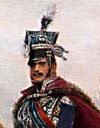The preliminary orders were issued late on the 6th. Five bridges were to be built over the Kalatsha, west of Brordino, in addition to three large artillery redoubts holding 120 guns for the massive bombardment of the Russian positions which would open the morrow's battle. There is evidence of poor staff work concerning the siting of these batteries; the guns were placed out of range of their targets, and consequently had to be moved forward from their prepared positions before they could open fire on the 7th - such an error would not have slipped past Napoleon's eagle eye in the days of his prime. (*such as the siege of Toulon in 1793) Indeed his ill-health seems to have taken a heavy toll of his efficiency on this occasion. However, a newly delivered portrait of the infant King of Rome helped to rally the Emperor's spirits, and Napoleon spent much of the evening showing it off to his officers and Guard.
Finally, at 2:00 A.M. the next morning, a proclamation was issued to the troops. "Soldiers!" it ran. "Here is the battle you have so long desired! Henceforward, victory depends on you; we have need of it. We will win ourselves abundance of supplies, good winter quarters, and prompt return to our Motherland. Conduct yourselves as you dd at Austerlitz, Friedland, Vitebsk and Smolensk, so that posterity will for ever acclaim with pride your conduct on this day; let them say of each of you: 'He took part in the great battle beneath the walls of Moscow!' "
An hour before dawn on September 7, the five infantry corps, the Guard and the four formations of the cavalry reserve, a total of 103,000 infantry and gunners, 28,000 cavalry and 587 guns, moved off to take up their assigned positions. Shortly after 6:00 A.M. the artillery of the Guard, together with the guns of the Ist and IIIrd Corps thundered into action, and poured a hail of shot at the Russian positions.
~ D. Chandler, The Campaigns of Napoleon, p. 799-800

























































No comments:
Post a Comment